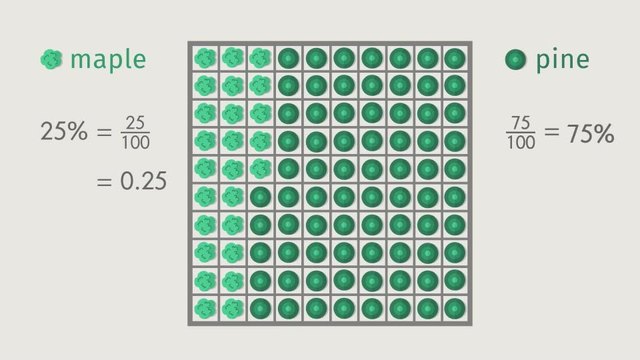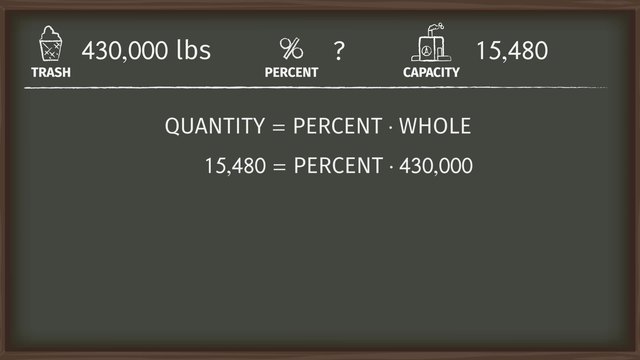Taking Percentages of a Percent


Basics on the topic Taking Percentages of a Percent
After this lesson, you will be able to solve problems involving percentages of a percent.
The lesson begins by reviewing how to use the proportion, “part” over “whole” equals percent, to solve for a missing “part”. It then illustrates how repeating this process can lead to finding percentages of a percent, using the “part” you found as the new “whole”, then solving for the new “part”.
Learn how to find a percent of a percent by helping Heathcliff research exotic island birds!
This video includes key concepts, notation, and vocabulary such as whole (the total); part (a portion of the total that fit a certain criteria); percent (an amount per 100); and the equation, Part/Whole = Percent/100.
Before watching this video, you should already be familiar with setting up and solving proportional equations using a part, whole, and percent.
After watching this video, you will be prepared to solve all types of percent problems.
Common Core Standard(s) in focus: 6.RP.3.c A video intended for math students in the 6th grade Recommended for students who are 11-12 years old
Transcript Taking Percentages of a Percent
Heathcliff, the bird food mogul, is on a mission. He's headed to the Pilopitos Islands, home to a large population of birds. On the islands, he'll study the birds and find out what they think of his new specialty bird food product Soylent Bird. To determine whether his product is a success, Heathcliff will have to understand the eating habits of the islands' birds by taking percentages of a percent. First, Heathcliff takes notes on what the birds already like to eat. There are 800 birds living on the Pilopitos Islands. Some prefer fruit and others, seeds. Heathcliff observes that 30 percent of the birds prefer to eat fruit while the rest, or 70 percent, prefer to eat seeds. Which means what exactly? First, let's determine the number of birds that prefer fruit, or 30 percent of 800. Our whole is 800, our percent is 30, and we need to find the part! We know that the 'part' over the 'whole' is an equivalent fraction to the 'percent' over 100. So, in our case, we have that the 'part' over 800 is equal to 30 over 100. Let 'p' represent the part. By cross-multiplying isolating the variable and solving for 'p' we find that 240 is 30% of 800. So 240 birds prefer fruit. Following the same procedure for the seed-eaters, we have that our whole is 800, our percent is 70, and we need to find the part! So, in other words, the number of birds that prefer seeds out of 800 birds is equal to 70 over 100. Cross-multiplying isolating the variable and solving for 'p' we find that 560 birds prefer to eat seeds on the Pilopitos Islands. Now that Heathcliff has completed his research he's ready to introduce the Pilopitos Islands to his refreshing product. After observing the birds carefully, he finds that, of the birds that prefer fruit 15 percent of them now prefer Soylent Bird. And of the birds who prefer seeds, 25 percent are now converts to Heathcliff's new product. But what does it all mean? Heathcliff wants to know how many birds on the island now eat Soylent Bird. In order to figure this out, we must take the percentage of a percent meaning that we must calculate 15 percent of 30 percent of the 800 birds on the islands to figure out how many birds that preferred fruit now prefer Soylent Bird ...of 70 percent of the 800 birds to figure out how many that preferred seeds now also prefer his new product. First, let's look at the percentage of birds that prefer fruit and find the percentage of that percent which now prefer Soylent Bird. We already know 30 percent, or 240 birds, of the 800 prefer fruit and 15 percent of this percentage prefer Soylent Bird. So our whole is now 240, our percent is 15, and we want to find our part! Setting up our proportion as usual cross-multiplying isolating the variable and then solving for our part shows us that of the 240 birds that prefer fruit 36 of them now prefer Soylent Bird. Not bad, Heathcliff. Next, let's look at the seed-eaters. We already know 70 percent, or 560 birds, of the 800 prefer seeds and 25 percent of this percentage prefer Soylent Bird. So our whole is now 560, our percent is 25, and we want to find our part! Setting up our proportion and solving for the part, 'p' tells us that 'p' equals 140 birds. Whoa! Not bad for a brand-new bird food! We want to know the total number of birds that now prefer Soylent Bird. So we need to add together the number of fruit-eaters and seed-eaters that now prefer Soylent Bird 36 plus 140 equals 176 -- that means 176 birds on the Pilopitos Islands are now crazy about Heathcliff's next big hit! In general, it's no problem to find a percentage of a percent. First, we find the missing 'part' for the first percentage. Like how in our first example one of the missing 'parts' was the fruit-eaters. Then we use the 'part' from the first percentage as the 'whole' for the second percentage. Like how in Heathcliff's case the number of fruit-eaters from the first percentage became the 'whole' for the second percentage. By following theses steps, we can be sure to find the percentage of a percent. Soylent Bird is a huge hit on the Pilopitos Islands! Heathcliff can't wait to unload the rest of his shipment. But wait, where have all the birds gone? Uh oh, Heathcliff's boat is leaving without him! All aboard the S.S. Soylent Bird! Papaya!

















